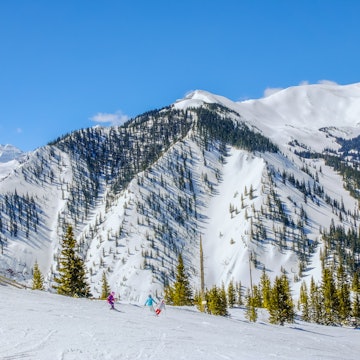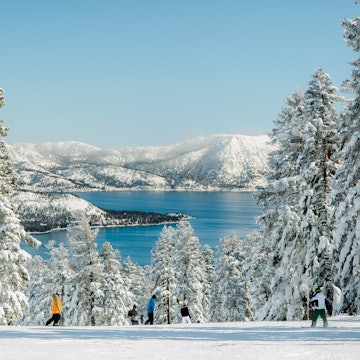
9 things you need to know before traveling to Yosemite National Park

Apr 16, 2025 • 8 min read

The trail to Half Dome. R.M. Nunes/Shutterstock
National park superstar Yosemite, established in 1864, entices first-time visitors with its 760,000 acres of wilderness, vast sections of which truly are accessible to all if you plan ahead. Despite the park's fame and well-established infrastructure (some areas can accommodate an estimated 4 million visitors per year), it is still surprisingly easy to find solitude along with all that dazzling nature, including charging waterfalls, soaring granite domes, deep valleys, emerald green forests and giant sequoia trees.
Stays in either the well-connected Yosemite Valley or the rugged backcountry are equally humbling experiences. Repeat adventurers seek to conquer the park's legendary hikes (including sections of the John Muir and Pacific Crest Trail), which have reached almost mythical status worldwide and made household names out of outdoorsy people who tackled them in style, including climber Alex Honnold and hiker Cheryl Strayed.
Recent rule changes may leave spontaneous travelers disappointed, however. And those who ignore proper park etiquette could ruin this protected space for generations to come. Here are some essential tips you should know before visiting Yosemite National Park.
1. Allow for a few days (or weeks, depending on your plans)
How long you spend in the park really depends on what you want to do. A day is enough to do a couple of hikes and get a sense of the awe of the place, but three days will allow you to see all the main sights, plus some hidden beauties. Those who want to go into the wilderness can spend weeks or months in the park, depending on how long they want their adventure to last.
Planning tip: The park entrance fee ($20 on foot or bicycle, $35 by car) is good for seven days, while an annual pass ($70) and the America the Beautiful National Parks and Federal Recreational Lands Pass ($80) are valid for a year.

2. Each season has a great glory and an equal caveat
Winter in Yosemite is spectacular – the park turns into a frosty wonderland, with snow-tipped peaks and frozen lakes – and you’ll likely have the trails to yourself. But be prepared for temperatures below freezing and for some areas of the park to be closed (including the roads through the High Sierras). Spring is the time to visit if you want to see rushing waterfalls, as the snow melt from the mountains flows into the rivers around the park. Be aware that river levels may be too high to cross on some trails, forcing you to U-turn.
Summer is the most popular time of year, with traffic jams and packed trails and shuttles, but early summer provides the chance to swim in Yosemite’s designated spots. It is also immensely busy in early fall, when the landscape begins to pop with fiery reds and golds. Autumn is a truly magical time of year, but the whole of the world knows it – if solitude is scarce in Yosemite Valley, head into the backcountry.
Planning tip: The park requires timed entry reservations for day visitors – folks who aren't camping or staying in park lodgings – to curb the crowds during the busy season. You'll need to book a reservation for weekends and holidays from April to the end of June, and from late August to the end of October. If you're visiting from July to mid-August, you'll need a reservation no matter the day of the week.
3. Pay attention to permits
Visitors can face disappointment after paying to enter the park and then realizing they need a permit for the trail they want to hike. Most day hikes can be done without a permit, but wilderness hikes (including all overnight stays) and the popular Half Dome path (with its steep drops and cable-assisted climbs) require a permit.
A maximum of 300 permits are given out each day for Half Dome (roughly 225 a day for day hikers and 75 for backpackers), which can be obtained by lottery (via recreation.gov) either during preseason (March 1 to 31) or two days before you want to hike. Half Dome cables are usually up from the last week of May to the second week of October. Most wilderness permits can be obtained by lottery 24 weeks in advance; the others can be booked seven days in advance.
Planning tip: It costs $10 to apply for a permit (nonrefundable), then $5 per person if your group is granted a permit. The size of the group must be detailed as part of your permit application, and only one member of each group can apply.

4. Pitch your tent in the wilderness or at a campground
If you’ve got a wilderness camping permit, you can camp anywhere in Yosemite’s wilderness (with the exception of the areas around the five High Sierra Camps and Little Yosemite Valley, where you have to camp in designated areas). There are also wilderness campgrounds, but these can fill early, so be prepared to find your own camping spot. The campgrounds in Yosemite Valley have toilets and potable water, spaces for RVs and accessible camp spots (apart from Camp 4), but none of the park’s campgrounds have hookups.
Planning tip: Reservations (via recreation.gov) are required at campgrounds in Yosemite Valley. Other camping areas may have walk-in sites, including South of Yosemite Valley and North of Yosemite Valley, but these fill up fast in peak season. Campgrounds cost between $10 and $36 per night. The only showers are at the Curry Village pool, and they cost $5 per person. There are more than two dozen guesthouses and hotels inside the park's perimeter, and booking in advance is recommended.
5. Hop aboard the shuttle bus
Yosemite has some fantastic drives, but the majority of visitors enter via Yosemite Valley, which can get clogged with traffic in peak times. Take the shuttle bus into the valley if possible. These continuously loop around, making 19 stops, including at major trailheads. Between 7am and 10pm, the Valleywide Shuttle runs every 12 to 22 minutes, while the East Valley Shuttle runs every 8 to 12 minutes.
If you drive, enter the park at nonpeak times and avoid holidays to beat the crowds. Prepare for delays of an hour or more at park entrances and expect to wait for parking spaces. Some high-altitude roads close during the winter months due to snowfall – these are usually plowed in spring. Check for updates at the visitors center or online before you set off.
Planning tip: Fill up with gas before you enter the park. There are two gas stations in Yosemite National Park but none in Yosemite Valley.

6. Leave no trace
Hikers and campers should "pack in, pack out," which means leaving no trace of their stay – no trash, food or anything else left in the wild. It also means not disturbing flora or fauna to make your camp. The motto is "campgrounds are found not made." When in the backcountry, solid human waste can be left in holes dug at least 6 inches deep in soil (and at least 100 feet from water, campsites and trails), and all toilet tissue should be taken with you. You must also camp at least 100 feet from water sources and any cultural or historic sites.
Avoid making a campfire and cook on a portable stove instead, so as not to disturb your surroundings. However, if you do have a fire, only collect wood from the ground that can be broken by hand. Put campfires out completely.
On trails, hikers progressing uphill have priority, so if you are going downhill, step to the side and let other hikers pass.
Do not follow, feed or approach wildlife in the park – in fact, keep your distance. If camping, be bear aware; use the bear locker or a canister to store your food away from your tent. Use a bell on trails, so bears know you are approaching and aren't startled. Don’t leave food in your car overnight.

7. Don't push your limits
While the trails around Yosemite Valley are well maintained and quickly attended when there is a hazard, hikers are more likely to face challenges in the backcountry, from changing weather and landslides, fast-flowing rivers or fallen trees blocking the trails to fires and more. Any one of these conditions may make trails inaccessible or unsafe. Before you go into the wild, check the status at the visitors center, which will have the most up-to-date weather and hiking information. If you come across an issue on a trail, only tackle what you are capable of and report potential hazards to rangers when you finish your hike.
Some hikes involve climbing, hiking along ledges or crossing rivers – if in doubt of your ability, don’t continue. Be aware of elevation changes and distances. Don’t overestimate the distance you can hike at high altitudes and on steep ascents.
The straight section of a river is generally the safest to cross, but don’t attempt to cross a river that is more than thigh deep. Never swim in a river in Yosemite; check at the visitors center for designated swimming spots in the park.
8. Pack accordingly
For multiday hikes, plan your food and water consumption. Check where you can fill up water bottles on the route and use sterilizing tablets or a water filter when filling up from wild water sources.
Take the right gear on hikes. Temperatures in Yosemite can be warm and sunny during the day and plummet at night. Bring waterproof outer shells for you and your gear, plus warm clothes and camping equipment to avoid hypothermia.
Planning tip: Don’t rely on your cell phone: the signal is patchy and almost nonexistent in the backcountry. Take a waterproof paper map, or use GPS or download offline maps before you enter the park.
9. Practice patience and courtesy
Due to staffing cuts, the National Park Service is stretched this year. Travelers can expect longer wait times, fewer services and the potential closures of certain areas. Be prepared and flexible.















